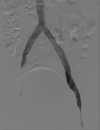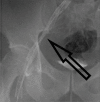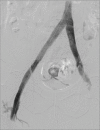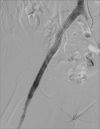Iliocaval stenting for May-Thurner syndrome: Initial experience
- PMID: 36128351
- PMCID: PMC9479514
- DOI: 10.25259/JCIS_82_2022
Iliocaval stenting for May-Thurner syndrome: Initial experience
Abstract
The aim of this report is to describe our experience in endovascular treatment of May-Thurner syndrome. We report three cases of iliocaval stenosis treated endovascularly at our institution. We included three patients age range from 41 to 85 years with two presenting with acute deep vein thrombosis and associated limb swelling and one with chronic lower limb symptoms. We reviewed the technical success, complications, and stent patency on follow-up, latter was monitored be serial imaging. The three cases of iliocaval stenosis were treated with endovascular stenting with follow-up imaging follow-up period ranged from 6 to 13 months (mean 5.6 months) with two out of the three cases maintaining stent patency. One case was complicated by intraprocedural reopening of previously venous bleed. Clinical symptoms resolved with no recurrence in two out of three cases. One case experienced symptomatic in-stent thrombosis following endovascular treatment. Endovascular treatment of iliocaval stenosis appears effective in immediate technical success. Periprocedural attention to anticoagulation and stent position are important in preventing in-stent restenosis.
Keywords: Chronic venous insufficiency; Deep vein thrombosis; May–Thurner syndrome; Venous stent.
© 2022 Published by Scientific Scholar on behalf of Journal of Clinical Imaging Science.
Conflict of interest statement
There are no conflicts of interest.
Figures








References
Publication types
LinkOut - more resources
Full Text Sources
